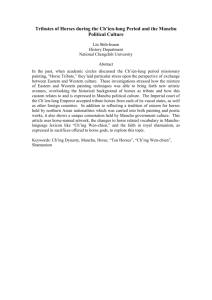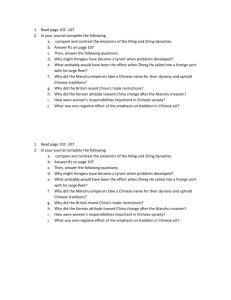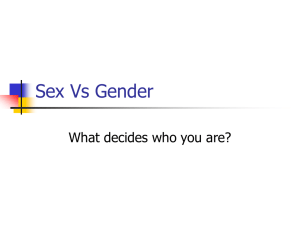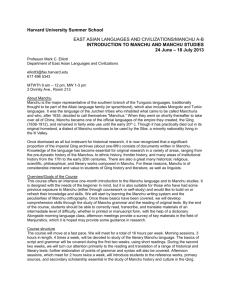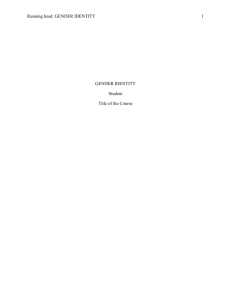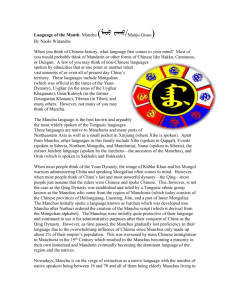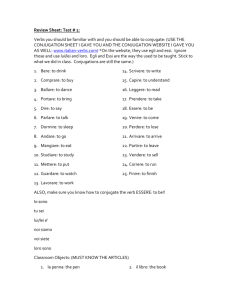Sibemanchu1
advertisement
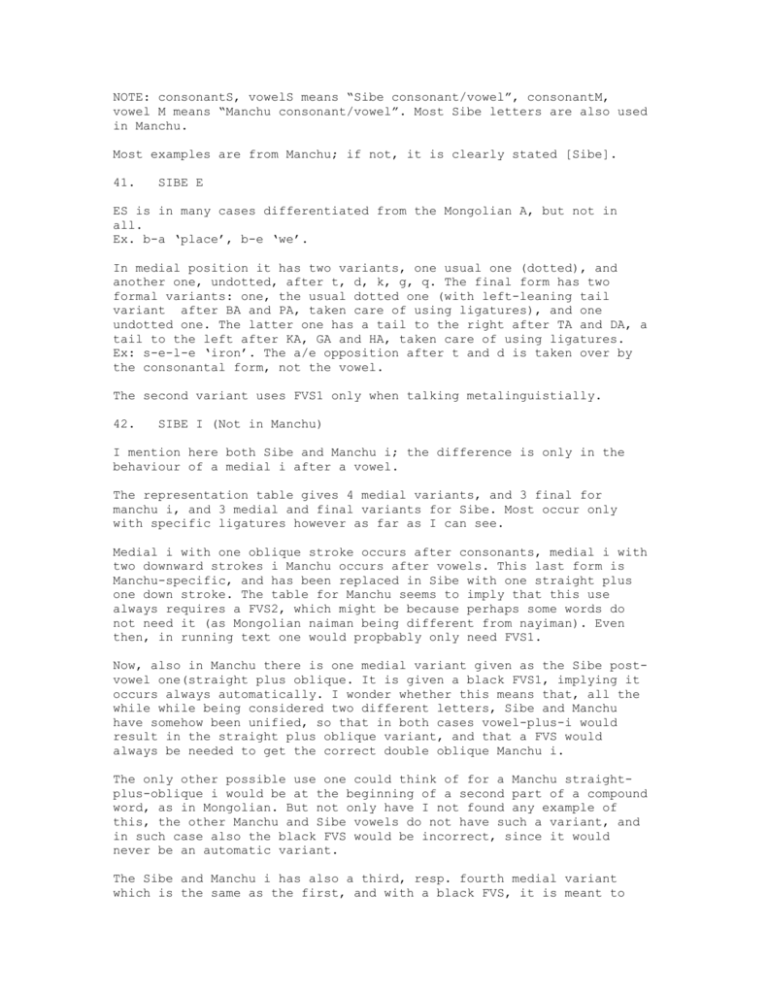
NOTE: consonantS, vowelS means “Sibe consonant/vowel”, consonantM, vowel M means “Manchu consonant/vowel”. Most Sibe letters are also used in Manchu. Most examples are from Manchu; if not, it is clearly stated [Sibe]. 41. SIBE E ES is in many cases differentiated from the Mongolian A, but not in all. Ex. b-a ‘place’, b-e ‘we’. In medial position it has two variants, one usual one (dotted), and another one, undotted, after t, d, k, g, q. The final form has two formal variants: one, the usual dotted one (with left-leaning tail variant after BA and PA, taken care of using ligatures), and one undotted one. The latter one has a tail to the right after TA and DA, a tail to the left after KA, GA and HA, taken care of using ligatures. Ex: s-e-l-e ‘iron’. The a/e opposition after t and d is taken over by the consonantal form, not the vowel. The second variant uses FVS1 only when talking metalinguistially. 42. SIBE I (Not in Manchu) I mention here both Sibe and Manchu i; the difference is only in the behaviour of a medial i after a vowel. The representation table gives 4 medial variants, and 3 final for manchu i, and 3 medial and final variants for Sibe. Most occur only with specific ligatures however as far as I can see. Medial i with one oblique stroke occurs after consonants, medial i with two downward strokes i Manchu occurs after vowels. This last form is Manchu-specific, and has been replaced in Sibe with one straight plus one down stroke. The table for Manchu seems to imply that this use always requires a FVS2, which might be because perhaps some words do not need it (as Mongolian naiman being different from nayiman). Even then, in running text one would propbably only need FVS1. Now, also in Manchu there is one medial variant given as the Sibe postvowel one(straight plus oblique. It is given a black FVS1, implying it occurs always automatically. I wonder whether this means that, all the while while being considered two different letters, Sibe and Manchu have somehow been unified, so that in both cases vowel-plus-i would result in the straight plus oblique variant, and that a FVS would always be needed to get the correct double oblique Manchu i. The only other possible use one could think of for a Manchu straightplus-oblique i would be at the beginning of a second part of a compound word, as in Mongolian. But not only have I not found any example of this, the other Manchu and Sibe vowels do not have such a variant, and in such case also the black FVS would be incorrect, since it would never be an automatic variant. The Sibe and Manchu i has also a third, resp. fourth medial variant which is the same as the first, and with a black FVS, it is meant to occur automatically. I can therefore not see what is meant here, except for a ligature based one (e.g., in gi-, qi-) The second and third final variants of i also seem to me only to occur in ligatures, after rounded consonants; I cannot find any other possibilities for these –i forms. The second variant would be as in isolated qi, gi; and for the third I would not know anything except when talking metalinguistically about part of the second form. MVS-iM/iS occurs with iM/S in the final form after MVS, although in Sibe often Manchu n MVS-iM has become –n-iS, or –n-iS-y-eS etc. So, my guess is that Manchu b-a-i-FVS1-m-b-i ‘search for (people)’ would need a FVS, but only FVS1. Equally Manchu s-a-i-FVS1-n ‘good’. 43. SIBE IY Often transcribed as y. This letter occurs only after certain special consonants denoting sounds taken from Chinese: Sibe tsa plus iy would be ‘ci’. S plus iy is Chinese ‘si’: ex. s-iyS-ch-ue-w-a-n ‘Sichuan’. Often the y is also used to transcribe the ‘i’ form when it has the same sound as above, after the Sibe ch, zh e.g. This is not followed here as input, and one should use i, i.e., zS-ue-zhS-i-qS-eS-n ‘organization’ 44. SIBE UE Note that this letter is usually transcribed “u”, not “ue”. It has two variants for medial and final: one usual dotted one, one undotted one after after t, d, k, g, q. The o/ue opposition after t and d is taken over by the consonantal form, not the vowel. It forms ligatures with q, g etc., loosing its final tail. The second form only occurs with FVS1 when talking metalinguistically. 45. SIBE U Note that this variant is often transcribed ‘u macron’. It has no special variants, but occurs in Sibe only after k, g, h, while in Manchu it occurs much more widely. NOTE: I am not sure whether in Sibe there can be a distinction between kS-ueS and kS-uS etc.; however, all tables seem to agree that the two letters are kept separate not only for Manchu but also for Sibe, and probably the following words are still current in Sibe: o-b-o-kM-uS ‘wash basin’, eS-r-iM-kM-ue ‘whisk broom’. 46. SIBE ANG (Not in Manchu) Sibe final –ng has a straight line for the –g part, while Mongolian and Manchu have an oblique form. Manchu m-ueS-ng m-a-ng ‘(sound donkeys make) vs. Sibe m-ueS-ngS m-a-ngS (?if the latter occurs). 47. SIBE KA (Not in Manchu) I have here treated Sibe KA and Manchu KA together; the latter has dotted feminine variants, and the medial and final masculine form before consonants differ in Sibe and Manchu (the first has one, the second two strokes) There are two sets of variants: masculine before a, o and u, and feminine before e, i and ue. (Note that this uses the Unicode transcriptions of u and ue.): kM-u-b-ueS-l-iM-m-b-iM ‘change’, kM-ueSb-ueS-n ‘cotton’, n-a-kM-a-m-b-iM ‘stop’, eS-kM-iM-s-a-kM-a ‘quiet’. The masculine set has a medial undotted variant before vowels, and a double front-dotted variant before consonants (with two strokes in Manchu, one stroke in Sibe). The feminine form, always undotted, usually forms ligatures with specific vowels. Sibe does therefore not need FVS in running text for this. From the representation table it is clear that entry would start with feminine isolate, using a ZWJ to make this masculine initial, etc. Manchu and Sibe however differ in that Manchu has double-dotted feminine variants alongside nondotted ones before consonants and as a final, and some FVS will be necessary. Manchu KA would still start as feminine isolate, but FVS would be necessary to have dotted feminine medial before consonant, and final feminine with dots. (In the metalinguistic table, FVS3 resp. FVS2 are used for this, but in running text FVS1 should suffice.) However, the rules on how to decide whether a medial-before-consonant or a final KA should be written with a masculine or feminine form is NOT like Mongolian. The masculine form is always used unless there is 1. a previous syllable k-ue, g-ue, q-ue or q-u, or 2. a syllable containing e EXCEPT if this syllable is t-e. Yet exceptions to this also occur: for the moment, I have given such exceptions a FVS2, but they may conflict with the feminine dotted-versus-undotted opposition. Although in one table still feminine Sibe pre-consonant medial and final are given, from other contrasting examples it seems that Sibe uses masculine forms in such circumstances, with single-stroke variants. Ex. a-kM-s-a-m-b-iM ‘avoid’ [dotted, masculine]; eS-kM-shS-eS-m-b-iM ‘haste’ [undotted feminine] but eS-kM-FVS1-shS-eSm-b-iM ‘haste’ [dotted feminine]. In Sibe: eS-kS-shS-eS-m-b-iS ‘haste’ [dotted masculine, one stroke] kM-iM-l-ue-kM ‘ride a horse’ [dotted masculine] ueS-kM-s-ue-n ‘lineage’ [dotted masculine] l-a-kM s-eS-m-eS ‘just in time’ [dotted masculine] l-eS-kM-s-e-i ‘align’ [undotted feminine] s-eS-kM s-eS-m-eS ‘suddenly’ [undotted feminine] eS-dS-eS-m-eS-kM ‘(placename)’ [undotted feminine] fM-iM-kM fM-iM-kM ‘very crowded’ [dotted masculine, 2-stroke] versus Sibe fS-iS-kS fS-iS-kS [dotted masculine, 1-stroke] But : qS-iM-y-eS-kM-FVS2-dS-eS-n m-o-o ‘baomu wood (?) (<Qingwen zonghui) [dotted masculine, not undotted feminine] 48. SIBE GA There are two sets of variants: masculine before a, o and u, and feminine before e, i and ue. (Note that this uses the Unicode transcriptions of u and ue.) The forms, always single back-dotted, only occur before vowels. Note that the dot typographically may go to the following vowel instead; yet the vowels o vs. ue or a vs. e cannot be confused because of the form of the consonant. Ex.: a-gS-a ‘rain’, eS-m-gS-iM ‘with’, gS-o ‘golden plaque’, gS-ue ‘jade’. 49. SIBE QA Also often transcribed ‘h’. There are two sets of variants: masculine before a, o and u, and feminine before e, i and ue. (Note that this uses the Unicode transcriptions of u and ue.) The forms, always single back-circled, only occur before vowels. Note that the circle typographically may go to the following vowel instead. Ex.: a-s-qS-a ‘wing’, eS-l-qS-eS ‘peaceful’ 50. SIBE PA Only in form differs from Mongolian; no special behavior. Frequently uses ligatures. Ex. fM-eS-m-pS-iM-l-eS-m-b-iM ‘close’, pS-ue-l-ue pS-a-l-a ‘coarse’ 51. SIBE SHA. No special rules required. shS-iM stands for the Chinese “shi” and is not pronounced like English ‘she’. Ex. qS-a-shS-i-gS-a-rM ‘Kashgar’. Note that transcribed s-h may stand for s-qS: s-iM-s-qS-e ‘cotton mattress’, usually transcribed as ‘sishe’. 52. SIBE TA There are 2 sets of forms: one before a, i and o, the other one before e, u and ue. Note that this is not the usual masculine/feminine behavior. TA differs from DA in that the latter has a dot. The a-e, ue-o opposition is with TA and DA not shown through the dots with the vowel, but through the forms of the consonant. Ex: tS-eS-tS-eS-l-eS ‘hitherto’, ueS-tS-a ‘milk cookie’. TA has special forms before a consonant and as final. Ex: ueS-tS-qS-aiM ‘immediately’, dS-ueS-rM-b-eS-tS ‘Durbet’. 53. SIBE DA There are 2 sets of forms: one before a, i and o, the other one before e, ue (Sibe/Manchu u does not occur). Note that this is not the usual masculine/feminine behavior. DA differs from TA in that it has a dot. The a-e, ue-o opposition is with TA and DA not shown through the dots with the vowel, but through the forms of the consonant. Ex: dS-a-s-a-n ‘government’, dS-eS-m-b-eS-iM ‘very’. DA does not occur before a consonant or as final. 54. SIBE JA (Not in Manchu) Manchu uses the Mongolian JA, with a different medial form from Sibe: s-ue-n-j-a ‘five’. Sibe uses a much more simplified form of JA, with only initial and medial forms. I know of no uses of the latter; it is not pointed out in overviews which contrast Sibe with Manchu. 55. SIBE FA (Not in Manchu) Sibe FA uses one form for the sound f everywhere, while Manchu FA uses one before a and e, and another one (with the form of Mongolian WA) before i, o, ue and u. Sibe distinguishes FA from WA in all cases. Manchu only before a and e. Ex: fM-a-rM-s-iM ‘piece’, fM-o-qS-o-l-o-n ‘short’, Manchu w-eS ‘who?’, Manchu eS-fM-ue ‘brother in law’ versus Sibe eS-fS-ue. 56. SIBE GAA (G2S) Often transcribed as g’. Occurs only before a, o: g2s-a-l-dS-a-n ‘Galdan’, jS-ue-ng-g2S-o ‘China’. 57. SIBE HAA (H2S) Often transcribed as h’. Occurs only before a, o, has sound of feminine q before e. No word examples. 58. SIBE TSA Transcribes the Chinese pinyin “c” (ts’). Occurs before a, e, o, ue. Before i the i is written as the form called here Sibe iy. Ex.: tsS-a-i ‘Cai (surname)’, tsS-o-o-tsS-o-o “Cao Cao”, tsS-ue-n ‘Chinese inch’ 59. SIBE ZA Transcribes the Chinese pinyin “z” (ts). Occurs before a, e, i, o, ue. (Before i, pronounced as Chinese zi, not as English dzi). Ex.” zS-eSngM-zS-i ‘Zeng zi”, zS-ue-n qS-uS-w-a ‘Zunhua’. 60. SIBE RAA Transcribes the Chinese pinyin “r”.Occurs before a, e, i, o, and ue, but pronunciation before i is as Chinese “ri”. Ex: rS-eS-qS-o “Rehe=Jehol”, zS-i-b-eS-n “Japan” 61. SIBE CHA Often transcribed as c’. Occurs only before i; the pronunciation is then as Chinese “chi”, not as English “chee”, which it would be if Mongolian CHA would have been used. Ex. chS-iS-m-iS-ngM “edict” 62. SIBE ZHA (Not in Manchu) In form Sibe zha is different somewhat from Manchu zha. Usage is probably the same: Sibe/Manchu zh occur only before i, to transcribe Chinese pronunciation “zhi”; Mongolian j-iM or Sibe jS-iS would be ‘zhee’. Ex. tS-ue-ngM-zhS-iM “comrade’. 63. MANCHU I I mention here both Sibe and Manchu i; the difference is only in the behaviour of a medial i after a vowel. The representation table gives 4 medial variants, and 3 final for Manchu i, and 3 medial and final variants for Sibe. Most occur only with specific ligatures however as far as I can see. Medial i with one oblique stroke occurs after consonants, medial i with two downward strokes i Manchu occurs after vowels. This last form is Manchu-specific, and has been replaced in Sibe with one straight plus one down stroke. The table for Manchu seems to imply that this use always requires a FVS2, which might be because perhaps some words do not need it (as Mongolian naiman being different from nayiman). Even then, in running text one would propbably only need FVS1. Now, also in Manchu there is one medial variant given as the Sibe postvowel one(straight plus oblique. It is given a black FVS1, implying it occurs always automatically. I wonder whether this means that, all the while while being considered two different letters, Sibe and Manchu have somehow been unified, so that in both cases vowel-plus-i would result in the straight plus oblique variant, and that a FVS would always be needed to get the correct double oblique Manchu i. The only other possible use one could think of for a Manchu straightplus-oblique i would be at the beginning of a second part of a compound word, as in Mongolian. But not only have I not found any example of this, the other Manchu and Sibe vowels do not have such a variant, and in such case also the black FVS would be incorrect, since it would never be an automatic variant. The Sibe and Manchu i has also a third, resp. fourth medial variant which is the same as the first, and with a black FVS, it is meant to occur automatically. I can therefore not see what is meant here, except for a ligature based one (e.g., in gi-, qi-) The second and third final variants of i also seem to me only to occur in ligatures, after rounded consonants; I cannot find any other possibilities for these –i forms. The second variant would be as in isolated qi, gi; and for the third I would not know anything except when talking metalinguistically about part of the second form. MVS-iM/iS occurs with iM/S in the final form after MVS. So, my guess is that Manchu b-a-i-FVS1-m-b-i ‘search for (people)’ would need a FVS, but only FVS1. 64. I have dotted before second MANCHU KA here treated Sibe KA and Manchu KA together; the latter has feminine variants, and the medial and final masculine form consonants differ in Sibe and Manchu (the first has one, the two strokes) There are two sets of variants: masculine before a, o and u, and feminine before e, i and ue. (Note that this uses the Unicode transcriptions of u and ue.): kM-u-b-ueS-l-iM-m-b-iM ‘change’, kM-ueSb-ueS-n ‘cotton’, n-a-kM-a-m-b-iM ‘stop’, eS-kM-iM-s-a-kM-a ‘quiet’. The masculine set has a medial undotted variant before vowels, and a double front-dotted variant before consonants (with two strokes in Manchu, one stroke in Sibe). The feminine form, always undotted, usually forms ligatures with specific vowels. Sibe does therefore not need FVS in running text for this. From the representation table it is clear that entry would start with feminine isolate, using a ZWJ to make this masculine initial, etc. Manchu and Sibe however differ in that Manchu has double-dotted feminine variants alongside nondotted ones before consonants and as a final, and some FVS will be necessary. Manchu KA would still start as feminine isolate, but FVS would be necessary to have dotted feminine medial before consonant, and final feminine with dots. (In the metalinguistic table, FVS3 resp. FVS2 are used for this, but in running text FVS1 should suffice.) However, the rules on how to decide whether a medial-before-consonant or a final KA should be written with a masculine or feminine form is NOT like Mongolian. The masculine form is always used unless there is 1. a previous syllable k-ue, g-ue, q-ue or q-u, or 2. a syllable containing e EXCEPT if this syllable is t-e. Yet exceptions to this also occur: for the moment, I have given such exceptions a FVS2, but they may conflict with the feminine dotted-versus-undotted opposition. Although in one table still feminine Sibe pre-consonant medial and final are given, from other contrasting examples it seems that Sibe uses masculine forms in such circumstances, with single-stroke variants. Ex. a-kM-s-a-m-b-iM ‘avoid’ [dotted, masculine]; eS-kM-shS-eS-m-b-iM ‘haste’ [undotted feminine] but eS-kM-FVS1-shS-eSm-b-iM ‘haste’ [dotted feminine]. In Sibe: eS-kS-shS-eS-m-b-iS ‘haste’ [dotted masculine, one stroke] kM-iM-l-ue-kM ‘ride a horse’ [dotted masculine] ueS-kM-s-ue-n ‘lineage’ [dotted masculine] l-a-kM s-eS-m-eS ‘just in time’ [dotted masculine] l-eS-kM-s-e-i ‘align’ [undotted feminine] s-eS-kM s-eS-m-eS ‘suddenly’ [undotted feminine] eS-dS-eS-m-eS-kM ‘(placename)’ [undotted feminine] fM-iM-kM fM-iM-kM ‘very crowded’ [dotted masculine, 2-stroke] versus Sibe fS-iS-kS fS-iS-kS [dotted masculine, 1-stroke] But : qS-iM-y-eS-kM-FVS2-dS-eS-n m-o-o ‘baomu wood (?) (<Qingwen zonghui) [dotted masculine, not undotted feminine] 65. MANCHU RA Differs from Mongolian r only that it has a different final form: ex. ch-i-ch-i-gS-a-r “Qiqihar”. 66. MANCHU FA Sibe FA uses one form for the sound f everywhere, while Manchu FA uses one before a and e, and another one (with the form of Mongolian WA) before i, o, ue and u. Sibe distinguishes FA from WA in all cases. Manchu only before a and e. Ex: fM-a-rM-s-iM ‘piece’, fM-o-qS-o-l-o-n ‘short’, Manchu w-eS ‘who?’, Manchu eS-fM-ue ‘brother in law’ versus Sibe eS-fS-ue. 67. MANCHU ZHA In form Sibe zha is different somewhat from Manchu zha. Uasge is probably the same: Sibe/Manchu zh occur only before i, to transcribe Chinese pronunciation “zhi”; Mongolian j-iM or Sibe jS-iS would be ‘zhee’. Ex. tS-ue-ngM-zhS-iM “comrade’. NOTE ON MONGOLIAN NA, KA The usual Mongolian NA follows usual Mongolian behavior: dotted before vowels, undotted before consonants, undotted as final. Dotted variants in medial position before consonants, and as final, occur in personal and place names, and will necessitate FVS1: hS-a-n-FVS1-dS-eS-l-uS ‘Han Delu’, hS-a-n-FVS1 gS-uS-rM-uS-n ‘Han dynasty’. What is listed in the table as Mongolian KA, is used in Manchu and Sibe as KAA (K2S), that is, it is usually transcribed as k’, and only occurs before a and o, with a pronunciation as feminine k-. It is in usage therefore similar to g’ and h’. Ex: k2S(=K)-a-r-s-i ‘kasaya (Buddhist vestment)’, k2S-o-r-k2s-a ‘Korka’ (placename). k2S-a-dS-eS-r ‘cadre’(from Uyghur)=g2s-a-m-b-ue ‘cadre” <Chinese ganbu. NOTE ON CHINESE TRANSCRIPTIONS It is worth pointing out that where Manchu uses kM-iM, gS-iM, qS-i, Sibe regularly uses ch-iS, jS-iS and s-iS: Xiang Jiang is in Manchu qSiM-y-a-ngM gS-iM-y-a-ngM, in Sibe s-iS-y-a-ngS jS-iS-y-a-ngS In addition to Sibe letters, Sibe also uses Mongolian A (with regular behavior), O, NA, BA, MA, LA, SA, CHA (as CA), YA, RA, WA, and KA (as KAA). In addition to Manchu letters, Manchu also uses Mongolian A (with regular behavior), O, NA, ANG, BA, MA, LA, SA (with Manchu third final variant), CHA (as CA), JA, YA, WA, KA (as KAA). It also uses Sibe E, IY, UE, U, GA, QA(=HA), PA, SHA, TA, DA, GAA, HAA, TSA, ZA, RAA (as RA), CHA. Of these, note that “ya” does not occur before i.

